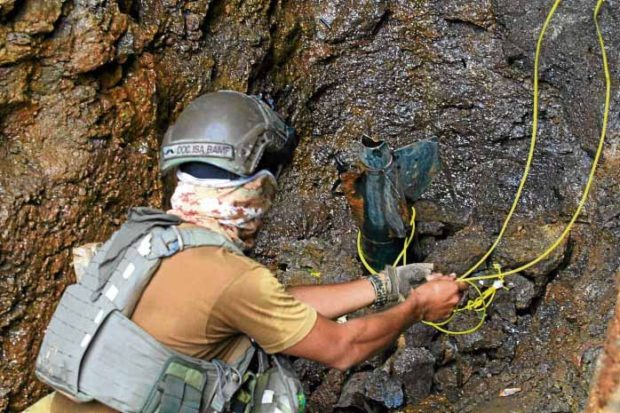
DETONATION JOB A member of an ordnance team prepares the cord to detonate a 117-
kilogram bomb found beneath the ruins of a mosque in Marawi City’s Barangay SabalaManaw in this file photo taken in October 2019. —RICHEL V. UMEL
ILIGAN CITY–Soldiers detonated on Sunday 83 assorted unexploded ordnance recovered in the second half of last year on the ground of the most affected area (MAA) of Marawi City’s 2017 siege, where new buildings and infrastructures were currently being built.
Lt. Col. Roy C. Tapat, commanding officer of the 553 Army Engineers, said most of the explosives were military-issued 40 millimeter projectiles which remained unexploded at the height of the fighting between government troops and the homegrown Islamic State-inspired terror group that occupied sections of the city five years ago.
The Joint Task Group Builder composed of the Army’s explosive ordnance and disposal unit and the 553 Engineer Battalion detonated the ordnance within the safe zone inside the MAA on Sunday, January 29, almost six years after the fighting that raged on for five months and rendered thousands of residents homeless, some of them still barred from returning home.
After the recovery of the unexploded weapons, the most affected area where most of the fighting occurred in 2017, is already 99 percent safe, according to Tapat.
This developed as residents who already complied with their building permit applications were already allowed to rebuild their houses in at least six barangays of MAA, Marawi City Mayor Majul Gandamra said.
Gandamra said around 1,000 residents whose building permits were approved and processed by the local government in the villages of Tulali, Monkado Kadingilan, Lilod Madaya, Marinaut and Kapantaran were already allowed to return and rebuild their homes.
He also advised those already building their houses in the area without the required building permits to stop and comply with the requirements first. “We advise those who have already started rebuilding their houses without securing the building permits to secure your permits first, before building your houses,” Gandamra said.
For years after October 2017, when the city was declared liberated by the government, residents in the 24 barangays declared as the MAA of the fighting, had pressured the government to allow them to go home to rebuild their houses destroyed during the fighting.
But the government had prevented them from doing so, saying that the “unexploded ordnance” could pose threats to their lives.
Aside from the residents in six barangays whose building permits had been approved, thousands of other displaced residents from the MAA still failed to return. Gandamra said the contract with the owners of the land being used as temporary shelters for the displaced persons was supposed to end in January this year but he had negotiated for its extension.
He also told the Inquirer that he and Governor Mamintal Adiong Jr., of Lanao del Sur had already sent to the Department of Human Settlement and Urban Development (DHSUD) the draft Implementing Rules and Regulations for the Marawi Compensation Law, for submission to Malacanang, hoping that the amount could help the displaced Marawi residents rebuild their lives.
He said that the Lanao del Sur Electric Cooperative Incorporated (Lasureco) had already installed power lines in the MAA, which residents could access at a very minimal cost.
Among the infrastructures that are being built, the Grand Padian Market and Convention Center is about to be completed while the Sarimanok Sports Stadium has already been used for the holding of public events. “Once fully completed, the facilities will be properly turned-over to the city government of Marawi City,” the mayor said.
RELATED STORY:
Marawi: City destroyed in Philippines’ longest urban war